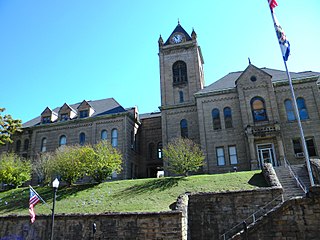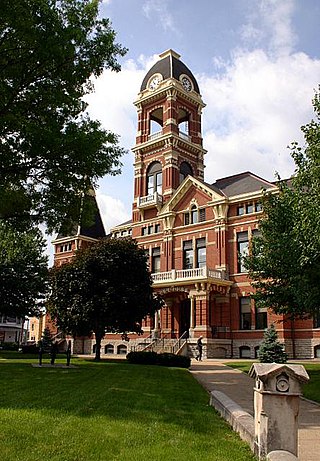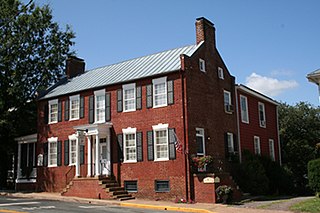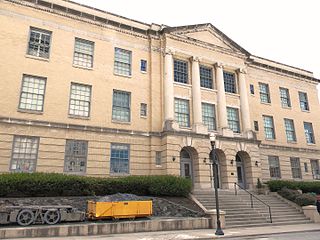
McDowell County is a county in the U.S. state of West Virginia. As of the 2020 census, the population was 19,111. Its county seat is Welch. McDowell County is the southernmost county in the state. It was created in 1858 by the Virginia General Assembly and named for Virginia Governor James McDowell. It became a part of West Virginia in 1863, when several Union-affiliated counties seceded from the state of Virginia during the American Civil War. McDowell County is located in the Cumberland Mountains, part of the Appalachia region.

Welch is a city in and the county seat of McDowell County, West Virginia, United States. The population was 3,590 at the 2020 census; the 2021 census estimate put the population at 1,914, due to the Federal Correctional Institution, McDowell leaving city limits. Welch was incorporated as a city in 1893.

Lyon Village is a neighborhood and urban village in Arlington County, Virginia, along Langston Boulevard. It adjoins Arlington County's government center, and is approximately one mile west of Rosslyn and less than a mile north of Clarendon, of which it is sometimes considered a sub-neighborhood, as is Cherrydale, the mostly residential district immediately west of Lyon Village.

Frank Pierce Milburn was a prolific American architect of the late 19th and early 20th centuries. His practice was primarily focused on public buildings, particularly courthouses and legislative buildings, although he also designed railroad stations, commercial buildings, schools and residences. Milburn was a native of Bowling Green, Kentucky who practiced as an architect in Louisville from 1884 to 1889; Kenova, West Virginia 1890–1895; Charlotte, North Carolina; Columbia, South Carolina; and Washington, D.C. after 1904. From 1902 Milburn was architect for the Southern Railway.

The McDowell County Courthouse is a historic courthouse in Welch, West Virginia. It was placed on the National Register of Historic Places on August 29, 1979.

The Hinton Historic District is a national historic district located at Hinton, Summers County, West Virginia. The original Hinton Historic District is bordered roughly by the Chesapeake and Ohio Railroad line, James Street, 5th Avenue, and Roundhouse. The boundary increase extended the district to include Mill Street. It was listed on the National Register of Historic Places in 1984 and revised in 2005.

Albert C. Nash (1825-1890) was an American architect best known for his work in Milwaukee and Cincinnati.

The Downtown Commercial Historic District in Muscatine, Iowa is a historic district that was listed on the National Register of Historic Places in 2006. At that time, it included 93 contributing buildings, one other contributing object, and 18 non-contributing buildings. The city of Muscatine was established as Bloomington in 1836. The original town was built on land that is generally flat along the Mississippi River. Residential areas were located on the surrounding hills. Commercial and industrial interests developed on the flatter land near the river. Muscatine's commercial and industrial center had developed in a 12-block area along Front Street, now Mississippi Drive, and 2nd Street between Pine Street and Mulberry Street by 1874. This area, represented by the Downtown Commercial Historic District, is the city's original commercial area. Within its boundaries is a large number of 19th-century commercial buildings, many of which were modified in the first half of the 20th century.

The Newcastle Commercial District in Newcastle, Wyoming comprises the commercial center of this isolated Wyoming town. The town developed along the Burlington and Missouri Railroad in the late 1880s, with the commercial district taking shape between 1890 and 1952. The district includes twenty-three buildings, primarily commercial buildings, including two properties that are separately listed on the National Register of Historic Places: the Weston County Courthouse and the Newcastle Main Post Office. All of the buildings are considered "contributing properties" to the historic district.

Glen Elk Historic District is a national historic district located at Clarksburg, Harrison County, West Virginia. The district encompasses 131 contributing buildings north of the central business district of Clarksburg. The area was developed after 1898, and contains a mixture of residential and commercial buildings. They include commercial warehouses built of brick and stone, small commercial buildings, housing specialty shops and eateries, and frame dwellings. Located in the district is the Baltimore and Ohio Railroad Depot (1903).

Algoma Coal and Coke Company Store, also known as Tug River Health Clinic, is a historic company store building located at Algoma, McDowell County, West Virginia. It was built in the 1948 to a design by Welch architect Hassel T. Hicks. It is a two-story building with a flat roof, with exterior walls of glazed yellow tile with alternating bands of red brick in the Moderne style. It originally housed a store and offices and has also been home to a health clinic.

Alexander Blount Mahood was a Bluefield, West Virginia-based architect.

Bramwell Historic District is a national historic district located at Bramwell, Mercer County, West Virginia. The district includes 65 contributing buildings and 2 contributing structures in the central business district and surrounding residential areas of Bramwell. Most of the buildings pre-date the 1920s. Notable buildings include the Bramwell Town Hall, Bryant Building, Masonic Hall, Cooper House (1910), Cooper Indoor Pool (1910), Cooper Garage Apartment (1910), Bank of Bramwell, Perry House, Hewitt House (1914-1915), Hewitt Garage Apartment (1914-1915), Mann House, Bramwell Presbyterian Church (1902), Goodwill House, Thomas House, Thomas Garage / Apartment, Buck/Bowen House, Mann Playhouse, Freeman House, and Former Holy Trinity Episcopal Church.

The Wharton County Courthouse Historic Commercial District is a 21-acre (8.5 ha) historic district in Wharton, Texas that was listed on the National Register of Historic Places in 1991. It includes works by architects Jules Leffland and Wyatt C. Hedrick and others. The NRHP listing included 46 contributing buildings and two contributing objects, as well as 31 non-contributing buildings and two non-contributing objects, on the blocks fronting on the courthouse square and on nearby blocks.

Edmond J. Eckel was an architect in practice in St. Joseph, Missouri, from 1872 until his death in 1934. In 1880 he was the founder of Eckel & Mann, later Eckel & Aldrich and Brunner & Brunner, which was the oldest architectural firm in Missouri prior to its eventual dissolution in 1999.

Orange Commercial Historic District is a national historic district located at Orange, Orange County, Virginia. One of Virginia's Main Street communities, it encompasses 61 contributing buildings in the central business district of Orange's county seat.

Luray Downtown Historic District is a national historic district located at Luray, Page County, Virginia. The district includes 75 contributing buildings, 1 contributing structure, and 3 contributing objects in the central business district of the town of Luray. They include residential, commercial, governmental, and institutional buildings in a variety of popular 19th and 20th century architectural styles. Notable buildings include the Skyline Building, Luray Motor Company (1935), Luray United Methodist Church (1899-1900), Luray Post Office (1938), Page County Record Building (1912), Bridge Theatre, Casey Jones Overall Factory (1922), Mansion Inn, Jordan-McKim Building, Hotel Laurance, and Mimslyn Inn (1930-1931). The contributing objects include the Confederate Monument (1918) and clock. Located in the district are the separately listed Luray Norfolk and Western Passenger Station and Page County Courthouse.

Charlottesville and Albemarle County Courthouse Historic District, also known as the Charlottesville Historic District is a national historic district located at Charlottesville, Virginia. The district encompasses the previously listed Albemarle County Courthouse Historic District and includes 269 contributing buildings and 1 contributing object in the city of Charlottesville. It includes the traditional heart of the city's commercial, civic, and religious activities, with early residential development and industrial sites located along the fringe. The commercial core is located along a seven block Downtown Mall designed by Lawrence Halprin (1916-2009). Notable buildings include the Albemarle County Courthouse, Levy Opera House, Number Nothing, Redland Club, Eagle Tavern, United States Post Office and Courts Building (1906), Christ (Episcopal) Church (1895-1898), Beth Israel Synagogue (1882-1903), Holy Comforter Catholic Church (1925), First Methodist Church (1924), McIntire Public Library (1919-1922), and Virginia National Bank (1916). Also located in the district are the separately listed Abell-Gleason House, William H. McGuffey Primary School, Thomas Jonathan Jackson sculpture, Robert Edward Lee sculpture, and Marshall-Rucker-Smith House.

Garry & Sheffey was a prominent architectural firm from Bluefield, the largest city in southern West Virginia. The named partners were Martin J. Garry and Robert A. Sheffey, who established their partnership in 1920. The firm was active until 1941, and locally was second only to that of Alex. B. Mahood.

The Mason Historic District in Mason, Texas is listed on the National Register of Historic Places. It was listed in 1974 and increased in 1991. The original district was 230 acres (0.93 km2) forming an irregular pattern along both sides of U.S. 87 and TX 29 which included 186 contributing buildings and six contributing structures. The increase added 14 contributing building and a contributing site on 20 acres (0.081 km2) roughly along Post Hill Rd. from College Ave. to Spruce St.






















